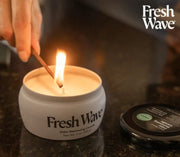Are Scented Candles Toxic?
Scented candles are an excellent item to keep in your cupboard for many reasons. They can contribute to a positive atmosphere in any room with their fragrance, take away bad odors and provide subtle mood lighting when you want it. However, consumers are becoming more aware that some scented candles may have issues with toxicity and cause harm to the environment. But in reality, are candles toxic? In this article, we aim to inform you of potential toxicity issues and let you know about the benefits of non-toxic candles. We will also answer questions like “is paraffin wax toxic?” and “are scented candles toxic?” Read on to learn more.
The Problems with Traditional Candles
Traditional candles are made using paraffin wax, which contains a number of harmful chemicals, and when burned, produces others that are harmful to human health. These include benzene, toluene and naphthalene, which are known carcinogens. The soot is also comparable to the exhaust from a diesel engine, containing large amounts of microparticles, which are known to add risk for heart disease and other cardiovascular problems. While some believe the risks to be minimal, other doctors have compared an hour of being in a room with a scented candle to smoking one cigarette. And this soot doesn’t just affect your lungs; it can leave nasty residues on your furniture and decor that smell bad and don’t clean away easily.
Unfortunately, the problems with paraffin wax don’t end there; paraffin is extracted from crude oil in energy-intensive processes that are bad for the environment. The crude oil itself is also toxic, and spills of crude oil have caused countless environmental disasters over the last century. So, any product that relies on the extraction of crude oil is by definition a bad choice for the planet.
On top of the problems with paraffin wax, you also need to consider the chemicals used in the scents. These are usually produced by chemical processes that cause pollution, and if natural scents are used, they are often obtained unsustainably. Even worse, the scent recipes are often a trade secret, so they are just listed as “scent” on the ingredients. This can cause problems with allergies for some people.
The Benefits of Non-Toxic Candles
Although paraffin wax candles dominated the market for a long time, you now have other choices when it comes to purchasing scented candles. Candles made from natural, sustainable materials like beeswax and soy wax are now widely available and come with fewer of the negatives associated with paraffin wax-based scented candles.
Beeswax and soy wax are not petroleum-based, so they don’t emit benzene or toluene. Instead, they burn cleanly with far fewer microparticles that are associated with breathing problems and lung cancer. As well as not emitting toxic chemicals, nontoxic candles can have health benefits too. For example, beeswax candles emit negative ions that cleanse the air, purifying it and improving your overall air quality. Of course, as with any burning process, they do emit carbon dioxide. However, this is equivalent to the carbon dioxide taken in by the plants these natural ingredients came from during their lifetime, so this balances out.
How to Choose a Non-Toxic Candle
So now you know paraffin scented candles are bad for you, your family and the environment, it should be easy to avoid potentially toxic and unsustainable candles, right? Well, sadly it’s not so simple. For example, a candle might be labeled as a “100% natural soy candle” and still contain paraffin wax alongside the soy, as paraffin wax can be considered natural, and the wording is ambiguous. Instead, look for labels like “made from 100% natural soy wax.” Besides paraffin wax, there are a couple of other things to look out for that you don’t want in a nontoxic candle. Ideally, you don’t want chemically made scents, so look out for scented candles that have sustainable essential oils on the ingredients list.
Palm oil is another one to avoid. This type of oil is often sourced in unsustainable ways that involve deforestation and the degradation of natural habitats for endangered animals such as orangutans. Check that the label says 100% soy wax or beeswax to ensure that there’s no unreported palm oil in there — after all, candles aren’t governed as tightly as food items, and not every ingredient has to be stated.
The next area to look at is the wick. In mass-produced scented candles, metal is often used to keep the candle straight, which can contribute to toxic emissions when you light the candle. Look for candles with wicks that are 100% cotton or wood.
If in doubt, checking the candles you’re looking at have certifications such as USDA Organic.
Keep Your Home Fresh with Non-Toxic Scented Candles You Can Trust
The decision on which scented candles to buy likely wasn’t one you put much thought into. But hopefully having read this post, you’ve learned that it’s a purchasing choice that has a direct impact on your health, your family’s health and the environment. Here’s a quick summary:
- Is paraffin wax toxic? Yes, it can be, and it’s also bad for the environment.
- Are scented candles toxic? Not necessarily — there are some very good nontoxic scented candles available.
- Are there any other benefits to using nontoxic scented candles? Yes! They’re also better for the environment and can improve the air quality in your home.
So why not make the switch to a nontoxic scented candle today and make a positive choice for your health and the good of the natural environment? At Fresh Wave, all our odor-eliminating candles are soy-based, made from all-natural ingredients and will make your home smell wonderful. So, try out our odor removing candles today!



